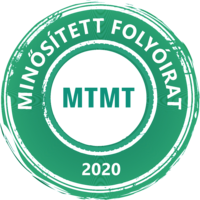Digital factory in the University of Pannonia Nagykanizsa Campus - the Factory Subsystem
DOI:
https://doi.org/10.14232/analecta.2019.1.21-27Keywords:
Industry 4.0, digital factory, innovation, communicationAbstract
One of the new challenges of the 21st century is the Industry 4.0. Manufacturing companies moving away from mass production and getting closer to customized production and manufacturing of customized products through digitization. The expectations are high, meeting the requirements is a real challenge to industrial partners. In order to help meet the challenges the University of Pannonia Nagykanizsa Campus started to establish a fully automatized industrial laboratory. In this paper the architecture of the Industry 4.0 laboratory and the purpose of the Factory Subsystem is presented.
Downloads
Download data is not yet available.
References
[1] Schmidt, R.; Möhring, M.; Härting, R.C.; Reichstein, C.; Neumaier, P.; Jozinovi´c, P. (2015): Industry 4.0-potentials for creating smart products: Empirical research results. In International Conference on Business Information Systems, Springer: Cham, Germany, 12: 16–27.
[2] Pereira, A.; Romero, F. (2017): A review of the meanings and the implications of the Industry 4.0 concept. Procedia Manuf., 13: 1206–1214.
[3] Ford, S.; Despeisse, M. (2016): Additive manufacturing and sustainability: An exploratory study of the advantages and challenges. J. Clean. Prod., 137: 1573–1587.
[4] Wang, S.; Wan, J.; Zhang, D.; Li, D.; Zhang, C. (2016): Towards smart factory for industry 4.0: A self-organized multi-agent system with big data based feedback and coordination. Comput. Netw., 101: 158–168.
[5] Xu, L.D.; Xu, E.L.; Li, L. (2018): Industry 4.0: State of the art and future trends. Int. J. Prod. Res., 56: 2941–2962.
[6] Martin, K. (2018): Innovative Competition with Chinese Characteristics. The Case of ’Made in China 2025’ in Relation to the German Industry. Bachelor’s Thesis, <https://openaccess.leidenuniv.nl/handle/1887/63733>. (7 September 2018).
[7] Shubin, T.; Zhi, P. (2018): “Made in China 2025” and “Industrie 4.0”—In Motion Together. In The Internet of Things; Springer: New York, NY, USA, 87–113.
[8] Huimin, M.; Wu, X.; Yan, L.; Huang, H.; Wu, H.; Xiong, J.; Zhang, J. (2018): Strategic Plan of “Made in China 2025” and Its Implementation. In Analyzing the Impacts of Industry 4.0 in Modern Business Environments; IGI Global: Derry Township, PA, USA, 23: 1–23.
[9] Liao, Y.; Deschamps, F.; de Freitas Rocha Loures, E.; Ramos, L.F.P. (2017): Past, present and future of Industry 4.0—A systematic literature review and research agenda proposal. Int. J. Prod. Res., 55: 3609–3629.
[10] Monostori, L. (2014): Cyber-physical production systems: Roots, expectations and R&D challenges. Procedia CIRP, 17: 9–13.
[11] Zhou, K.; Liu, T.; Zhou, L. (2015): Industry 4.0: Towards future industrial opportunities and challenges. In Proceedings of the 2015 12th International Conference on Fuzzy Systems and Knowledge Discovery (FSKD), Zhangjiajie, China, 2147–2152.
[12] Lanza, G.; Nyhuis, P.; Ansari, S.M.; Kuprat, T.; Liebrecht, C. (2016): Befähigungs-und Einführungsstrategien für Industrie 4.0. ZWF Zeitschrift Wirtschaftlichen Fabrikbetrieb, 111: 76–79.
[13] Lichtblau, K.; Stich, V.; Bertenrath, R.; Blum, M.; Bleider, M.; Millack, A.; Schmitt, K.; Schmitz, E.; Schroter, M. (2015): Industrie 4.0 Readiness. Impuls-Stiftung des VDMA Aachen-Köln, 52: 1–77.
[14] Schumacher, A.; Erol, S.; Sihn, W. (2016): A maturity model for assessing industry 4.0 readiness and maturity of manufacturing enterprises. Procedia CIRP, 52: 161–166.
[15] Munir, S.; Stankovic, J.A.; Liang, C.J.M.; Lin, S. (2013): Cyber Physical System Challenges for Human-in-the-Loop Control. In Proceedings of the Presented as part of the 8th International Workshop on Feedback Computing, USENIX, San Jose, CA, USA,; 4: 1–4.
[16] Hancock, P.A.; Jagacinski, R.J.; Parasuraman, R.;Wickens, C.D.;Wilson, G.F.; Kaber, D.B. (2013): Human-automation interaction research: Past, present, and future. Ergon. Des., 21: 9–14.
[17] Bidanda, B.; Ariyawongrat, P.; Needy, K.L.; Norman, B.A.; Tharmmaphornphilas, W. (2005): Human related issues in manufacturing cell design, implementation, and operation: A review and survey. Comput. Ind. Eng., 48: 507–523.
[18] Roitberg, A.; Perzylo, A.; Somani, N.; Giuliani, M.; Rickert, M.; Knoll, A. (2014): Human activity recognition in the context of industrial human-robot interaction. In Proceedings of the Signal and Information Processing Association Annual Summit and Conference (APSIPA), Siem Reap, Cambodia, 9–12 December; 10: 1–10.
[19] Ruppert, T.; Jaskó, Sz.; Holczinger, T.; Abonyi, J. (2018): Enabling Technologies for Operator 4.0: A Survey. APPLIED SCIENCES-BASEL 8: 9, Paper: 1650.
[20] Hawksworth, J.; Berriman, R.; Goel, S. (2018): Will Robots Really Steal Our Jobs? An International Analysis of the Potential Long Term Impact of Automation. <http://pwc.blogs.com/economics_in_business/2018/02/will-robots-really-steal-our-jobs.html> (20 July 2018).
[21] Reuter, M.; Oberc, H.; Wannöffel, M.; Kreimeier, D.; Klippert, J.; Pawlicki, P.; Kuhlenkötter, B. (2017): Learning factories’ trainings as an enabler of proactive workers’ participation regarding Industrie 4.0, Procedia Manufacturing, 9: 354–360.
[22] Erol, S.; Jaeger, A.; Hold, P.; Ott, K.; Sihn, W. (2016): Tangible Industry 4.0: a scenario-based approach to learning for the future production, Procedia CIRP, 54: 113–118.
[23] Prinz, C.; Morlock, F.; Freith, S.; Kreggenfiels, N.; Kremeier, D.; Kuhlenkoetter, B. (2016): Learning factory modules for smart factories in Industrie 4.0, Procedia CIRP, 54: 7–12.
[24] Simons, S.; Abé, P.; Neserb, S. (2017): Learning in the AutFab – the fully automated Industrie 4.0 learning factory of the University of Applied Sciences Darmstadt, Procedia Manufacturing, 9: 81–88.
[25] Elbestawi, M.; Centea D.; Singh, I.; Wanyama, T. (2018): SEPT Learning Factory for Industry 4.0 Education and Applied Research, Procedia Manufacturing, 23: 249–254.
[26] Abele, E.; Chryssolouris, G.; Sihn, W.; Metternich, J.; ElMaraghy, H.; Seliger, G.; Sivard, G.; ElMaraghy, W.; Hummel, V.; Tisch, M.; Seifermann, S. (2017): Learning factories for future oriented research and education in manufacturing, CIRP Annals, 66(2): 803–826.
[27] Tisch, M.; Hertle, C.; Cachay, J.; Abele, E.; Metternich, J.; Tenberg, R. (2013): A systematic approach on developing action-oriented, competency-based learning factories, Procedia CIRP, 7: 580–585.
[28] Mavrikios, D.; Sipsas, K.; Smparounis, K.; Rentzos, L.; Chryssolouris, G. (2017): A Web-based application for classifying teaching and learning factories, Procedia Manufacturing, 9: 222–228.
[29] Tisch, M.; Metternich, J. (2017): Potentials and limits of learning factories in research, innovation transfer, education, and training, Procedia Manufacturing, 9: 89–96.
[2] Pereira, A.; Romero, F. (2017): A review of the meanings and the implications of the Industry 4.0 concept. Procedia Manuf., 13: 1206–1214.
[3] Ford, S.; Despeisse, M. (2016): Additive manufacturing and sustainability: An exploratory study of the advantages and challenges. J. Clean. Prod., 137: 1573–1587.
[4] Wang, S.; Wan, J.; Zhang, D.; Li, D.; Zhang, C. (2016): Towards smart factory for industry 4.0: A self-organized multi-agent system with big data based feedback and coordination. Comput. Netw., 101: 158–168.
[5] Xu, L.D.; Xu, E.L.; Li, L. (2018): Industry 4.0: State of the art and future trends. Int. J. Prod. Res., 56: 2941–2962.
[6] Martin, K. (2018): Innovative Competition with Chinese Characteristics. The Case of ’Made in China 2025’ in Relation to the German Industry. Bachelor’s Thesis, <https://openaccess.leidenuniv.nl/handle/1887/63733>. (7 September 2018).
[7] Shubin, T.; Zhi, P. (2018): “Made in China 2025” and “Industrie 4.0”—In Motion Together. In The Internet of Things; Springer: New York, NY, USA, 87–113.
[8] Huimin, M.; Wu, X.; Yan, L.; Huang, H.; Wu, H.; Xiong, J.; Zhang, J. (2018): Strategic Plan of “Made in China 2025” and Its Implementation. In Analyzing the Impacts of Industry 4.0 in Modern Business Environments; IGI Global: Derry Township, PA, USA, 23: 1–23.
[9] Liao, Y.; Deschamps, F.; de Freitas Rocha Loures, E.; Ramos, L.F.P. (2017): Past, present and future of Industry 4.0—A systematic literature review and research agenda proposal. Int. J. Prod. Res., 55: 3609–3629.
[10] Monostori, L. (2014): Cyber-physical production systems: Roots, expectations and R&D challenges. Procedia CIRP, 17: 9–13.
[11] Zhou, K.; Liu, T.; Zhou, L. (2015): Industry 4.0: Towards future industrial opportunities and challenges. In Proceedings of the 2015 12th International Conference on Fuzzy Systems and Knowledge Discovery (FSKD), Zhangjiajie, China, 2147–2152.
[12] Lanza, G.; Nyhuis, P.; Ansari, S.M.; Kuprat, T.; Liebrecht, C. (2016): Befähigungs-und Einführungsstrategien für Industrie 4.0. ZWF Zeitschrift Wirtschaftlichen Fabrikbetrieb, 111: 76–79.
[13] Lichtblau, K.; Stich, V.; Bertenrath, R.; Blum, M.; Bleider, M.; Millack, A.; Schmitt, K.; Schmitz, E.; Schroter, M. (2015): Industrie 4.0 Readiness. Impuls-Stiftung des VDMA Aachen-Köln, 52: 1–77.
[14] Schumacher, A.; Erol, S.; Sihn, W. (2016): A maturity model for assessing industry 4.0 readiness and maturity of manufacturing enterprises. Procedia CIRP, 52: 161–166.
[15] Munir, S.; Stankovic, J.A.; Liang, C.J.M.; Lin, S. (2013): Cyber Physical System Challenges for Human-in-the-Loop Control. In Proceedings of the Presented as part of the 8th International Workshop on Feedback Computing, USENIX, San Jose, CA, USA,; 4: 1–4.
[16] Hancock, P.A.; Jagacinski, R.J.; Parasuraman, R.;Wickens, C.D.;Wilson, G.F.; Kaber, D.B. (2013): Human-automation interaction research: Past, present, and future. Ergon. Des., 21: 9–14.
[17] Bidanda, B.; Ariyawongrat, P.; Needy, K.L.; Norman, B.A.; Tharmmaphornphilas, W. (2005): Human related issues in manufacturing cell design, implementation, and operation: A review and survey. Comput. Ind. Eng., 48: 507–523.
[18] Roitberg, A.; Perzylo, A.; Somani, N.; Giuliani, M.; Rickert, M.; Knoll, A. (2014): Human activity recognition in the context of industrial human-robot interaction. In Proceedings of the Signal and Information Processing Association Annual Summit and Conference (APSIPA), Siem Reap, Cambodia, 9–12 December; 10: 1–10.
[19] Ruppert, T.; Jaskó, Sz.; Holczinger, T.; Abonyi, J. (2018): Enabling Technologies for Operator 4.0: A Survey. APPLIED SCIENCES-BASEL 8: 9, Paper: 1650.
[20] Hawksworth, J.; Berriman, R.; Goel, S. (2018): Will Robots Really Steal Our Jobs? An International Analysis of the Potential Long Term Impact of Automation. <http://pwc.blogs.com/economics_in_business/2018/02/will-robots-really-steal-our-jobs.html> (20 July 2018).
[21] Reuter, M.; Oberc, H.; Wannöffel, M.; Kreimeier, D.; Klippert, J.; Pawlicki, P.; Kuhlenkötter, B. (2017): Learning factories’ trainings as an enabler of proactive workers’ participation regarding Industrie 4.0, Procedia Manufacturing, 9: 354–360.
[22] Erol, S.; Jaeger, A.; Hold, P.; Ott, K.; Sihn, W. (2016): Tangible Industry 4.0: a scenario-based approach to learning for the future production, Procedia CIRP, 54: 113–118.
[23] Prinz, C.; Morlock, F.; Freith, S.; Kreggenfiels, N.; Kremeier, D.; Kuhlenkoetter, B. (2016): Learning factory modules for smart factories in Industrie 4.0, Procedia CIRP, 54: 7–12.
[24] Simons, S.; Abé, P.; Neserb, S. (2017): Learning in the AutFab – the fully automated Industrie 4.0 learning factory of the University of Applied Sciences Darmstadt, Procedia Manufacturing, 9: 81–88.
[25] Elbestawi, M.; Centea D.; Singh, I.; Wanyama, T. (2018): SEPT Learning Factory for Industry 4.0 Education and Applied Research, Procedia Manufacturing, 23: 249–254.
[26] Abele, E.; Chryssolouris, G.; Sihn, W.; Metternich, J.; ElMaraghy, H.; Seliger, G.; Sivard, G.; ElMaraghy, W.; Hummel, V.; Tisch, M.; Seifermann, S. (2017): Learning factories for future oriented research and education in manufacturing, CIRP Annals, 66(2): 803–826.
[27] Tisch, M.; Hertle, C.; Cachay, J.; Abele, E.; Metternich, J.; Tenberg, R. (2013): A systematic approach on developing action-oriented, competency-based learning factories, Procedia CIRP, 7: 580–585.
[28] Mavrikios, D.; Sipsas, K.; Smparounis, K.; Rentzos, L.; Chryssolouris, G. (2017): A Web-based application for classifying teaching and learning factories, Procedia Manufacturing, 9: 222–228.
[29] Tisch, M.; Metternich, J. (2017): Potentials and limits of learning factories in research, innovation transfer, education, and training, Procedia Manufacturing, 9: 89–96.
Downloads
Published
2019-06-25
How to Cite
Bakon, K. A., Skrop, A., Jaskó, S., & Holczinger, T. (2019). Digital factory in the University of Pannonia Nagykanizsa Campus - the Factory Subsystem. Analecta Technica Szegedinensia, 13(1), 21–27. https://doi.org/10.14232/analecta.2019.1.21-27
Issue
Section
Articles
License
Copyright (C) 2024 Authors
This work is licensed under a Creative Commons Attribution 4.0 International License.













